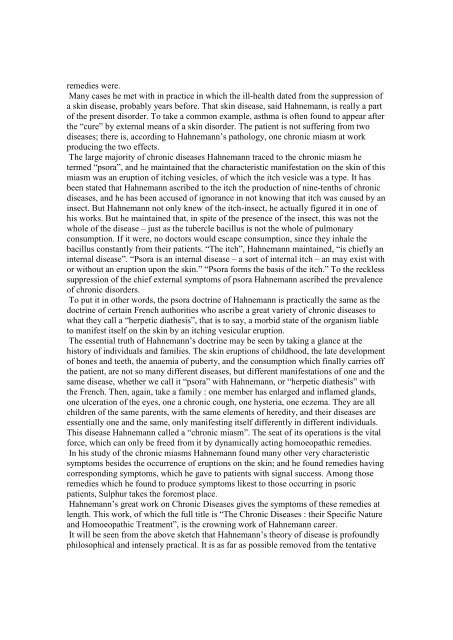CLARKE JH, Homoeopathy Explained - Classical Homeopathy Online
CLARKE JH, Homoeopathy Explained - Classical Homeopathy Online
CLARKE JH, Homoeopathy Explained - Classical Homeopathy Online
You also want an ePaper? Increase the reach of your titles
YUMPU automatically turns print PDFs into web optimized ePapers that Google loves.
emedies were.<br />
Many cases he met with in practice in which the ill-health dated from the suppression of<br />
a skin disease, probably years before. That skin disease, said Hahnemann, is really a part<br />
of the present disorder. To take a common example, asthma is often found to appear after<br />
the “cure” by external means of a skin disorder. The patient is not suffering from two<br />
diseases; there is, according to Hahnemann’s pathology, one chronic miasm at work<br />
producing the two effects.<br />
The large majority of chronic diseases Hahnemann traced to the chronic miasm he<br />
termed “psora”, and he maintained that the characteristic manifestation on the skin of this<br />
miasm was an eruption of itching vesicles, of which the itch vesicle was a type. It has<br />
been stated that Hahnemann ascribed to the itch the production of nine-tenths of chronic<br />
diseases, and he has been accused of ignorance in not knowing that itch was caused by an<br />
insect. But Hahnemann not only knew of the itch-insect, he actually figured it in one of<br />
his works. But he maintained that, in spite of the presence of the insect, this was not the<br />
whole of the disease – just as the tubercle bacillus is not the whole of pulmonary<br />
consumption. If it were, no doctors would escape consumption, since they inhale the<br />
bacillus constantly from their patients. “The itch”, Hahnemann maintained, “is chiefly an<br />
internal disease”. “Psora is an internal disease – a sort of internal itch – an may exist with<br />
or without an eruption upon the skin.” “Psora forms the basis of the itch.” To the reckless<br />
suppression of the chief external symptoms of psora Hahnemann ascribed the prevalence<br />
of chronic disorders.<br />
To put it in other words, the psora doctrine of Hahnemann is practically the same as the<br />
doctrine of certain French authorities who ascribe a great variety of chronic diseases to<br />
what they call a “herpetic diathesis”, that is to say, a morbid state of the organism liable<br />
to manifest itself on the skin by an itching vesicular eruption.<br />
The essential truth of Hahnemann’s doctrine may be seen by taking a glance at the<br />
history of individuals and families. The skin eruptions of childhood, the late development<br />
of bones and teeth, the anaemia of puberty, and the consumption which finally carries off<br />
the patient, are not so many different diseases, but different manifestations of one and the<br />
same disease, whether we call it “psora” with Hahnemann, or “herpetic diathesis” with<br />
the French. Then, again, take a family : one member has enlarged and inflamed glands,<br />
one ulceration of the eyes, one a chronic cough, one hysteria, one eczema. They are all<br />
children of the same parents, with the same elements of heredity, and their diseases are<br />
essentially one and the same, only manifesting itself differently in different individuals.<br />
This disease Hahnemann called a “chronic miasm”. The seat of its operations is the vital<br />
force, which can only be freed from it by dynamically acting homoeopathic remedies.<br />
In his study of the chronic miasms Hahnemann found many other very characteristic<br />
symptoms besides the occurrence of eruptions on the skin; and he found remedies having<br />
corresponding symptoms, which he gave to patients with signal success. Among those<br />
remedies which he found to produce symptoms likest to those occurring in psoric<br />
patients, Sulphur takes the foremost place.<br />
Hahnemann’s great work on Chronic Diseases gives the symptoms of these remedies at<br />
length. This work, of which the full title is “The Chronic Diseases : their Specific Nature<br />
and Homoeopathic Treatment”, is the crowning work of Hahnemann career.<br />
It will be seen from the above sketch that Hahnemann’s theory of disease is profoundly<br />
philosophical and intensely practical. It is as far as possible removed from the tentative
















